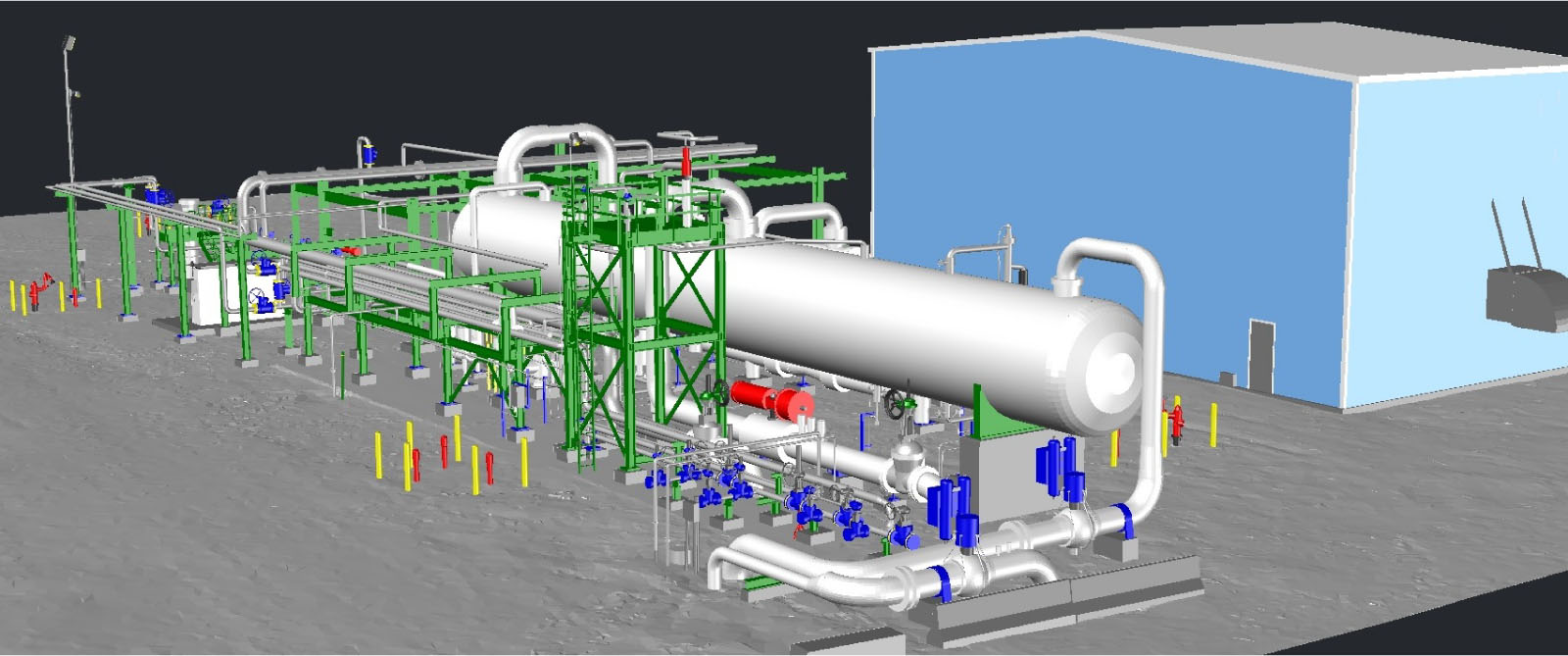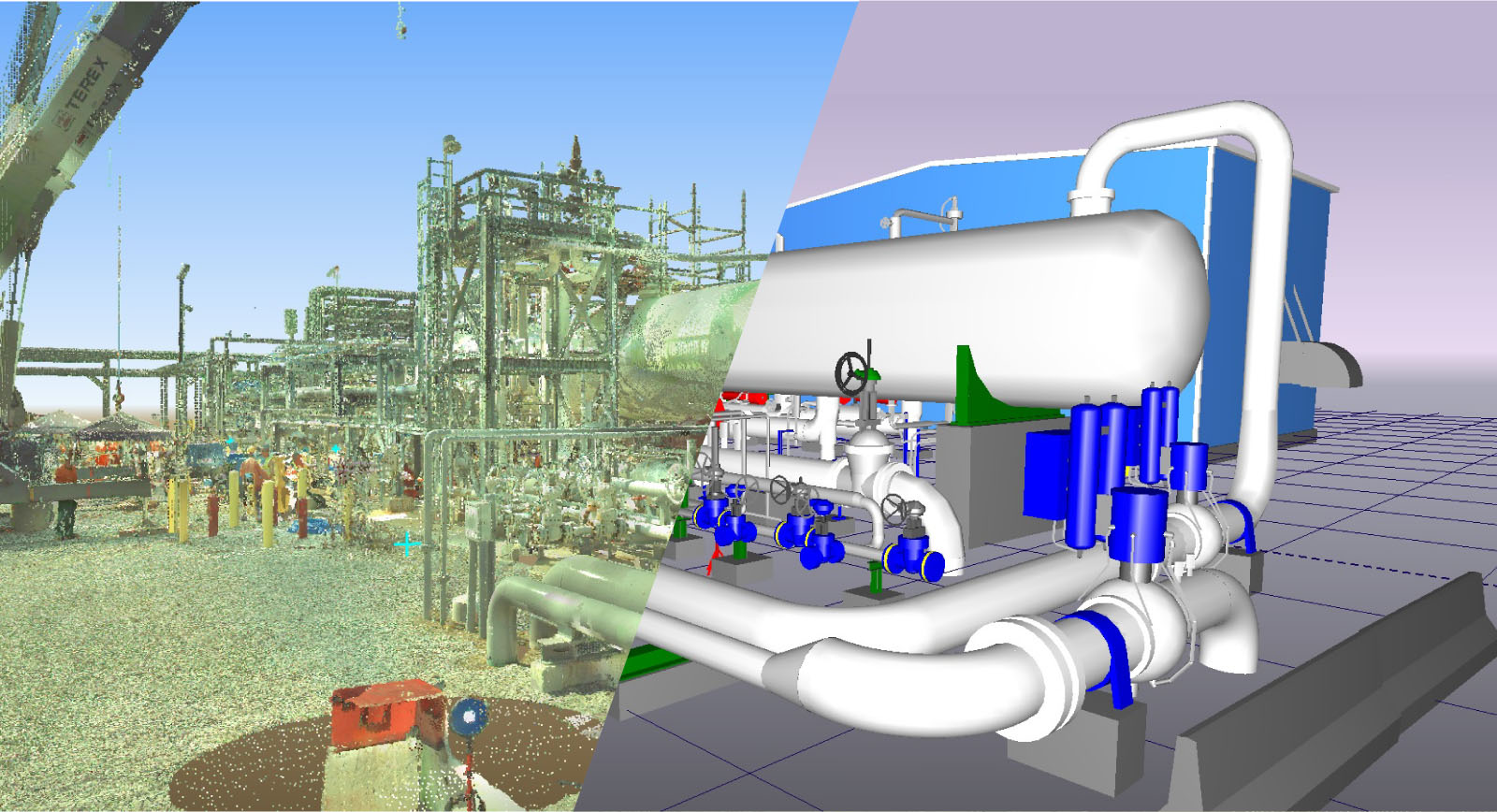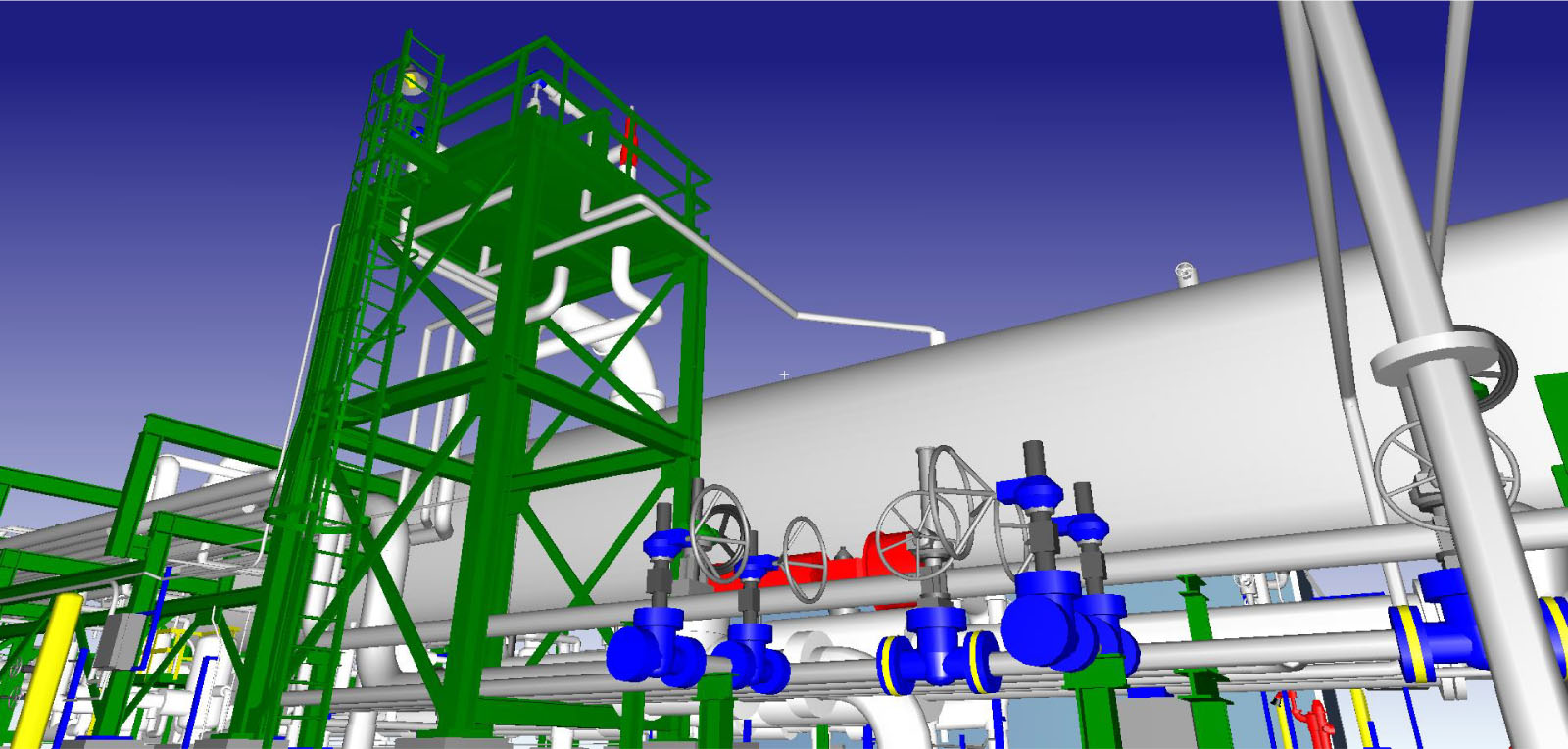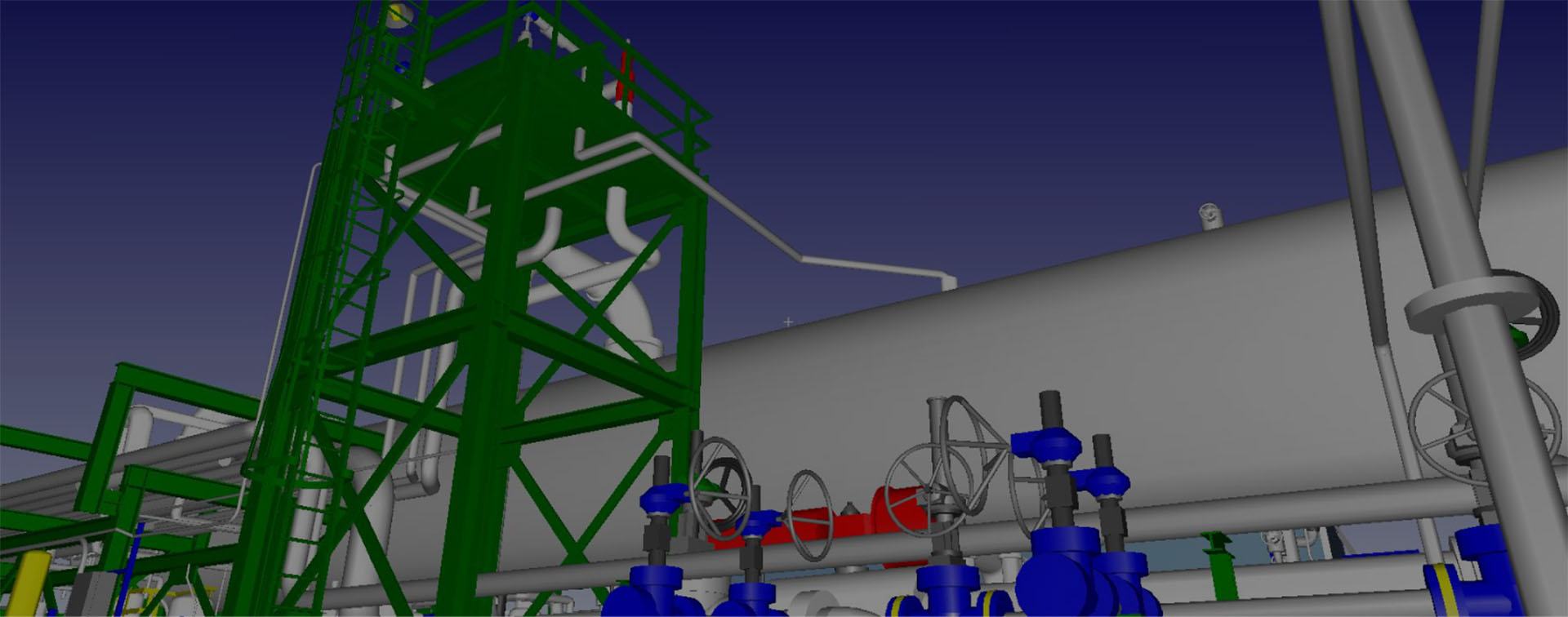It’s hard for me to fathom how this project could have been accomplished without laser scanning and 3D modeling,’ he says.
When plant engineers at a major midstream natural gas pipeline and processing company needed to install new piping and vessels in their facility, they asked I3 Engineering and Consulting, in Bridgeport, W. Va., to provide an engineering design for the installation. They also wanted an AutoCAD model to show how the new structures would fit within the plant’s web of pipes and vessels.
Company
I3 Engineering and Consulting Allegheny Surveys
Location
Bridgeport, WV
As Dave Mordan, president of I3 Engineering, reviewed the project’s scope, he was dismayed to find that the existing as-built documentation for plant structures was only on paper. These documents would be of little use in creating an AutoCAD model. Without a digital representation of existing pipes and vessels, it would be virtually impossible to engineer structures guaranteed to fit precisely with no interferences. It was like trying to thread a needle in the dark. Surveying every pipe, vessel and elevation in the area targeted for new construction would consume hundreds of manhours and leave the design engineers with the painstaking process of piecing it all together in a CAD model. Due to the limitations of the manual process and the vast amount of data required, the results were not likely to be comprehensive or entirely accurate.
Wanting to provide the most complete and precise engineering design in a cost effective and efficient way, Mordan turned to Allegheny Surveys, an engineering and surveying firm with offices in West Virginia and Ohio. Mordan had partnered with Allegheny on other projects and was aware that the firm offered 3D laser scanning. He understood that a laser scanner could swiftly capture all-inclusive, intricate detail by sweeping a laser beam over an area. It could essentially provide a panoramic snapshot, showing an accurate position for thousands of data points scanned. The resulting point cloud, a set of data points in a three-dimensional coordinate system, would accurately represent the scanned surfaces. Mordan believed this technology could help his team quickly and successfully overcome the lack of digital plant documentation.
Dwayne Matheny, senior survey manager at Allegheny Surveys, confirmed that his team could provide a model of the existing structures in files that would be easy to use in AutoCAD software. This model would enable I3 Engineering’s engineers to design new structures in a virtual environment, ensuring they would not clash with existing pipes and vessels.
Damon Wilkewitz, who manages Allegheny Surveys’ 3D laser scanning services, spearheaded the project. “It’s hard for me to fathom how this project could have been accomplished without laser scanning and 3D modeling,” he says.
Mordan believed this technology could help his team quickly and successfully overcome the lack of digital plant documentation.

Called upon by I3 Engineering and Consulting, Allegheny Surveys was able to acquire all required 3D laser scanning data in just four hours onsite.
Long-Distance Documentation
Safety is an inherent benefit of the laser scanning process because scanning enables surveyors to remain at a safe distance from dangerous objects… In this case, the project engineers at the natural gas plant needed accurate, detailed information on complex piping and structures that were 20 to 30 feet high.
Wilkewitz chose the Leica ScanStation C10 for the data collection because of the scanner’s ability to acquire targets accurately within a 300-meter range while capturing thousands of data points in a second. In fact, Allegheny Surveys had invested in the Leica ScanStation C10 because its long-range capabilities are ideal for safely surveying gas well pads, natural gas compressor stations, site topographies and plants—the company’s primary surveying applications.
Safety is an inherent benefit of the laser scanning process because scanning enables surveyors to remain at a safe distance from dangerous objects and with their feet firmly planted on the ground. In this case, the project engineers at the natural gas plant needed accurate, detailed information on complex piping and structures that were 20 to 30 feet high. Traditional documentation would have required technicians to use safety harnesses to climb into the racks or be hoisted in man baskets in order to take measurements and survey shots.
Also, on the day that Wilkewitz and his associate Scott Elliott, junior party chief, scanned the site, construction workers were working in the same area. Because Allegheny’s associates could capture data from a distance, the two crews were able to work safely and easily together.
Data in a Day
During the four-hour period at the plant, the team completed eighteen scanning setups and gathered all required data.
Allegheny Surveys’ two-man crew was quickly able to amass a vast amount of data. It took them about an hour and a half to reach the plant’s location. After they attended the required safety training class, they waited at the guard shack before being escorted to the plant area that they planned to scan. They arrived on location at 11:30 AM, and by 3:30 PM they were packing up their equipment, ready for the return trip. During the four-hour period at the plant, the team completed eighteen scanning setups and gathered all required data.
“I can’t even begin to imagine how long it would have taken to document the plant using conventional methods,” says Wilkewitz. He comments that a rodman carrying a prism pole would have had to lean it up against the side of the tank and take field notes on each of the many shots needed. Then, pulling all the data together back in the office would be a daunting task. “With laser scanning, you take the USB drive out of the scanner, plug it into your computer and you have a point cloud on your screen. It’s a virtual representation of the site that you can model in the comfort of your office,” he says.

Working with 3D laser scanning data provided by Allegheny Surveys, I3 Engineering and Consulting turned out models such as this for the natural gas plant’s new piping project.
Bringing the Plant Back to the Office
Back at his desk, Wilkewitz modeled the renovation area of the plant in approximately 70 hours using Leica Cyclone software. He made full use of Cyclone’s new I-beam fitting tool that enabled him to select from a library of standard I-beams and fit them over the point cloud. He simply had to choose a couple of geometrically precise points, or “pick points.” “When you select your pick points for I-beams on the point cloud, Cyclone chooses the correct manufactured piece of steel and fits it over the point cloud,” he says. This feature saved him time, since he no longer had to copy, paste and rotate I-beams throughout the model, and it also gave him peace of mind. “You know that what you’ve modeled is scaled to real-world manufactured pieces,” says Wilkewitz.
Wilkewitz has always been fascinated by making models in 3D, rotating them on his computer’s screen and being able to examine the fine details of a digital representation of a real-world location. “It was great to work with a point cloud depiction of the plant from the comfort of my office. I could model the site directly from the point cloud that let me pan around and zoom in on a digital environment,” he says.
Once he completed the design, he exported it in AutoCAD Drawing Exchange Format (DXF) to provide files that I3 Engineering could easily use. The result was that his team came in under budget and provided the model in less than two weeks.

A sample of the models produced by I3 Engineering and Consulting, working with 3D laser scanning data collected by Allegheny Surveys using Leica Geosystems solutions.
Laser Scanning Pays Off
It enabled us to provide a low-cost alternative along with an excellent work product. I would definitely use laser scanning again.
I3 Engineering’s associates estimate that by using laser scanning instead of traditional survey and as-built mod eling methods, they saved their client approximately $20,000 in field survey work and drafting time. Additionally, because they had accurate, comprehensive data and were able to complete virtual interference checks, they prevented from $5,000 to $10,000 in design rework costs based on industry averages.
Laser scanning has paid off in other ways for Allegheny Surveys. It has made it possible for them to turn around more projects for clients than ever before. Within a six-month period last year, they were able to deliver 50 scans of small gas well pads to clients. “Laser scanning is an amazing technology that has really paid off for us,” says Wilkewitz, noting that the benefits include increased productivity as well as the ability to attract more business.
Mordan also enjoyed using the technology for the first time. “It enabled us to provide a low-cost alternative along with an excellent work product. I would definitely use laser scanning again,” he says.
HIGH-VALUE DELIVERABLES
- High resolution registered point clouds
- Leica TruViews
- 3D CAD models
BENEFITS
Increased Safety
All data captured from ground level
Fast Data Collection
All data captured in a single day with a two-person crew vs. two weeks for a traditional documentation process provided a cost savings of 68%
Comprehensive Data Capture
Accurate, comprehensive data enabled virtual clash checks and prevented rework costs
Better Project Visualization
TruViews and 3D models enable stakeholders to make better decisions
